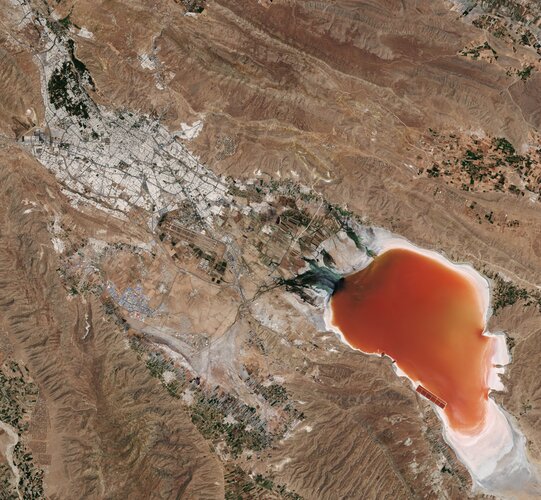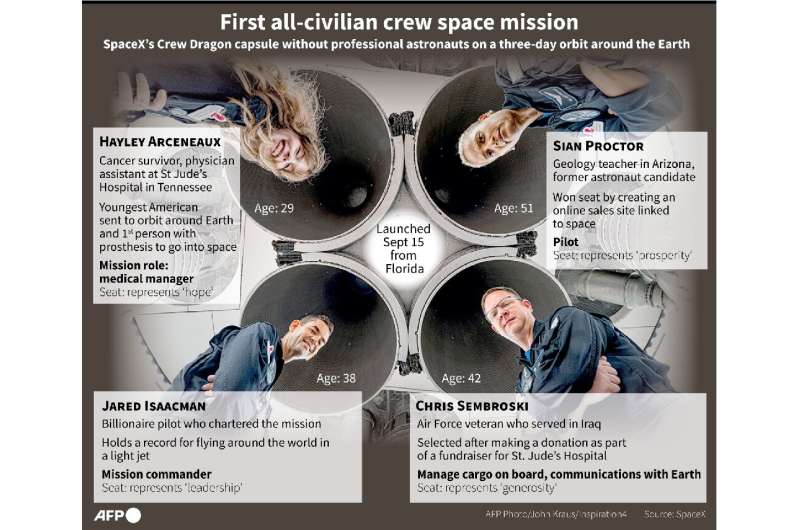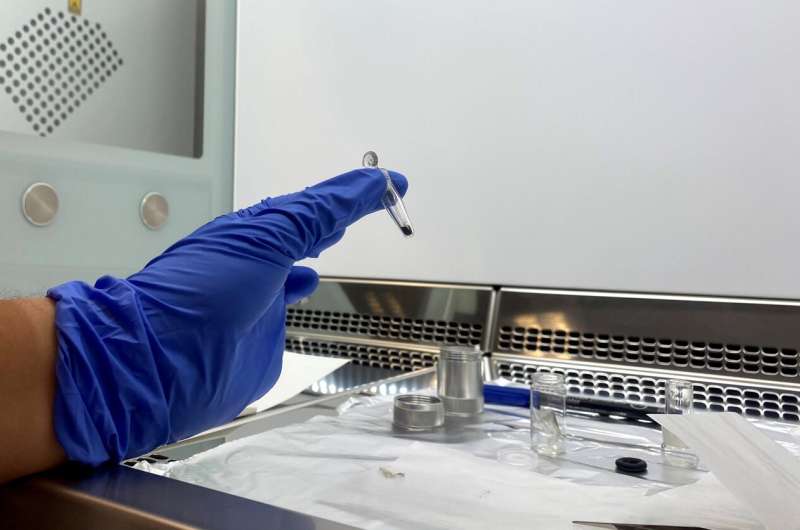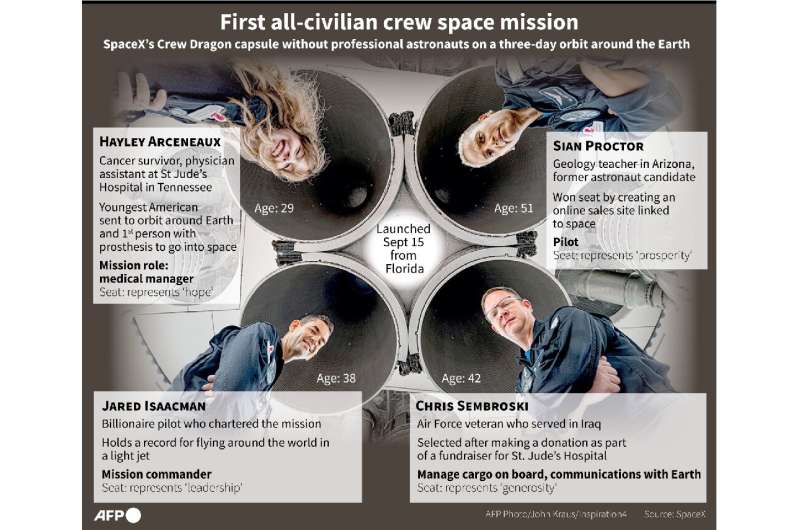
Copernical Team
Earth from Space: Maharloo Lake

Maharloo Lake, a seasonal salt lake in Iran, is featured in this image captured by the Copernicus Sentinel-2 mission.
'Happy' SpaceX tourist crew spend first day whizzing around Earth

SpaceX's all-civilian Inspiration4 crew spent their first day in orbit conducting scientific research and talking to children at a pediatric cancer hospital, after blasting off on their pioneering mission from Cape Canaveral the night before.
St Jude tweeted its patients got to speak with the four American space tourists, "asking the questions we all want to know like 'are there cows on the Moon?'"
Billionaire Jared Isaacman, who chartered the flight, is trying to raise $200 million for the research facility.
Inspiration4 is the first orbital spaceflight with only private citizens aboard.
Earlier, Elon Musk's company tweeted that the four were "healthy" and "happy," had completed their first round of scientific research, and enjoyed a couple of meals.
Musk himself tweeted that he had personally spoken with the crew and "all is well.
Modern snakes evolved from a few survivors of dino-killing asteroid
 A new study suggests that all living snakes evolved from a handful of species that survived the giant asteroid impact that wiped out the dinosaurs and most other living things at the end of the Cretaceous. The authors say that this devastating extinction event was a form of 'creative destruction' that allowed snakes to diversify into new niches, previously filled by their competitors.
The
A new study suggests that all living snakes evolved from a handful of species that survived the giant asteroid impact that wiped out the dinosaurs and most other living things at the end of the Cretaceous. The authors say that this devastating extinction event was a form of 'creative destruction' that allowed snakes to diversify into new niches, previously filled by their competitors.
The Russian actress says 'too late' to fear ISS launch
 Russian actress Yulia Peresild said Thursday it was "too late" for fear ahead of her launch into space, as Moscow races against Hollywood to film the first movie in orbit.
Russia's space agency Roscosmos is dispatching the 36-year-old screen star next month to the International Space Station (ISS) along with director Klim Shipenko, 38, in the race against time to beat a parallel US project.
Russian actress Yulia Peresild said Thursday it was "too late" for fear ahead of her launch into space, as Moscow races against Hollywood to film the first movie in orbit.
Russia's space agency Roscosmos is dispatching the 36-year-old screen star next month to the International Space Station (ISS) along with director Klim Shipenko, 38, in the race against time to beat a parallel US project. Inspiration4 crew circles the Earth on mission's first full day
 The crew of the first all-private orbital space mission has spent Thursday, the first full day of the mission, circling the Earth every 90 minutes at over 17,000 mph.
SpaceX reported the Crew Dragon Resilience capsule with four civilians inside was traveling 363 miles high over Asia as of mid-morning, quickly moving over the massive continent. The altitude is a full hundred miles higher
The crew of the first all-private orbital space mission has spent Thursday, the first full day of the mission, circling the Earth every 90 minutes at over 17,000 mph.
SpaceX reported the Crew Dragon Resilience capsule with four civilians inside was traveling 363 miles high over Asia as of mid-morning, quickly moving over the massive continent. The altitude is a full hundred miles higher Men may sleep worse on nights during the first half of the lunar cycle
 Men's sleep may be more powerfully influenced by the lunar cycle than women's, according to a new study from Uppsala University, now published in the journal Science of the Total Environment.
Previous studies have produced somewhat conflicting results on the association between the lunar cycle and sleep, with some reporting an association whereas others did not. There are several possible
Men's sleep may be more powerfully influenced by the lunar cycle than women's, according to a new study from Uppsala University, now published in the journal Science of the Total Environment.
Previous studies have produced somewhat conflicting results on the association between the lunar cycle and sleep, with some reporting an association whereas others did not. There are several possible Chinese astronauts return to earth after 90-day mission
 Three Chinese astronauts returned to Earth Friday after completing the country's longest-ever crewed mission, the latest landmark in Beijing's drive to become a major space power. The capsule carrying the trio deployed its parachute and landed in the Gobi desert at 1:34 pm local time (0534 GMT). "It feels very good to be back!," Tang Hongbo told state broadcaster CCTV after the 90-day mission, a record for China.
Three Chinese astronauts returned to Earth Friday after completing the country's longest-ever crewed mission, the latest landmark in Beijing's drive to become a major space power. The capsule carrying the trio deployed its parachute and landed in the Gobi desert at 1:34 pm local time (0534 GMT). "It feels very good to be back!," Tang Hongbo told state broadcaster CCTV after the 90-day mission, a record for China. Path set for commercial communications around the Moon

ESA confirmed a contract signature yesterday with Surrey Satellite Technology Ltd (SSTL) to be the main customer for their Lunar Pathfinder satellite launching in 2024 that will provide communications services around the Moon.
European facility prepares for haul of samples returning from planetary bodies

The Institute of Planetary Research at DLR (German Aerospace Center) is starting construction of a new Sample Analysis Laboratory (SAL) dedicated to the study of rock and dust samples from planetary bodies such as asteroids and the Moon. The first phase will be operational by the end of 2022, on time to welcome samples collected by the Hayabusa2 mission, and fully ready by 2023.
SpaceX's tourist crew 'healthy, happy and resting'

SpaceX's all-civilian Inspiration4 crew are "healthy, happy and resting comfortably," the company said Thursday in its first update since the pioneering mission blasted off from Cape Canaveral the night before.
The four American space tourists "traveled 5.5 times around Earth, completed their first round of scientific research, and enjoyed a couple of meals" before going to bed, Elon Musk's company said.
Musk tweeted that he had personally spoken with the crew and "all is well."
After waking up, they will get their first look out of the Dragon ship's cupola—a large observation dome that has been fitted onto the vessel for the first time, in place of a docking mechanism.
Billionaire Jared Isaacman, physician assistant Hayley Arceneaux, geoscientist Sian Proctor and aerospace data engineer Chris Sembroski are orbiting the globe at an altitude that at times reaches 590 kilometers (367 miles).
